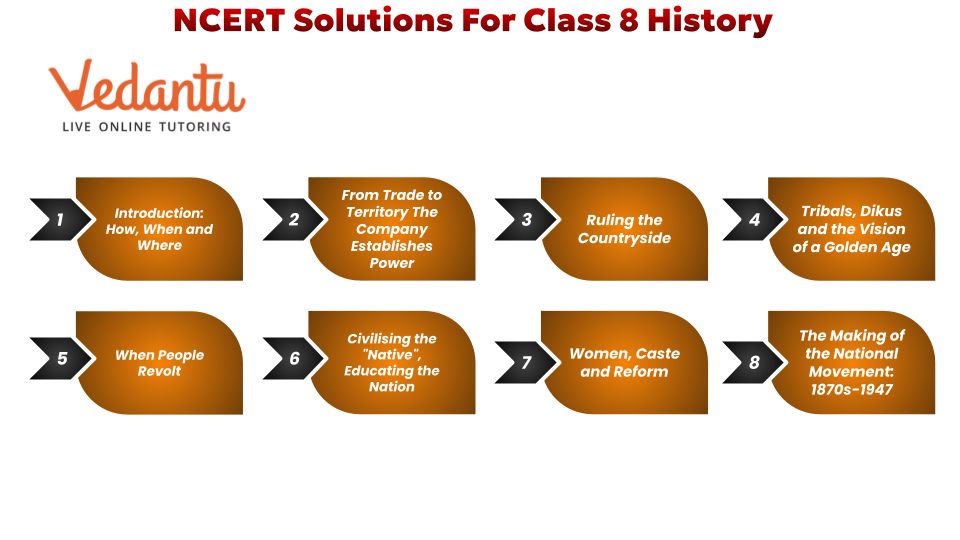Chapter-wise Class 8 Social Science Our Pasts 3 Questions and Answers Free PDF Download
FAQs on NCERT Solutions For Class 8 Social Science (2025-26)
1. What topics are covered in the NCERT Solutions for Class 8 Social Science Chapter 7, The Making of the National Movement?
The NCERT Solutions for Class 8 Social Science Chapter 7 provide detailed, step-by-step answers for all the exercises in the chapter 'The Making of the National Movement: 1870s-1947'. The solutions cover key topics such as the rise of nationalism, the formation of the Indian National Congress, the role of Moderates and Radicals, the impact of the partition of Bengal, and the beginning of the Gandhian era.
2. How should I structure my answer for the NCERT question about the political associations formed before the Indian National Congress in 1885?
When answering this question, you should follow a clear structure as guided by the NCERT solutions. Start by stating the common goal of these early associations, which was to empower Indians and work for the country's betterment. Then, list a few key examples provided in the textbook, such as the Poona Sarvajanik Sabha, the Indian Association, the Bombay Presidency Association, and the Madras Mahajan Sabha. Conclude by explaining that these organisations laid the groundwork for a pan-Indian entity like the Congress.
3. What key points are essential to include when solving the NCERT exercise on the partition of Bengal?
To solve the exercise on the partition of Bengal effectively, your answer must include these key points:
- The year of the partition (1905) and the Viceroy responsible (Lord Curzon).
- The official reason given by the British (administrative convenience) versus the actual reason (to weaken the nationalist movement in Bengal and divide Hindus and Muslims).
- The widespread opposition it sparked, leading to the Swadeshi Movement.
- The methods used during the Swadeshi Movement, such as boycotting British goods and promoting Indian ones.
4. Why is it important to use a step-by-step method to explain the growth of mass nationalism after 1919?
Using a step-by-step method, as demonstrated in the NCERT solutions, is crucial because the period after 1919 involved multiple interconnected events. A structured approach helps you to logically connect the dots between the end of the First World War, the harsh economic conditions, the repressive Rowlatt Act, the Jallianwala Bagh massacre, and the subsequent rise of Mahatma Gandhi's mass movements. This method prevents simple memorisation and encourages an analytical understanding of cause and effect.
5. How do the NCERT solutions for Chapter 7 explain the significance of the Dandi March?
The NCERT solutions explain the significance of the Dandi March by breaking it down into key impacts:
- It was a direct challenge to the unpopular British Salt Law, which symbolised the injustice of colonial rule.
- It successfully mobilised a vast number of people, including women, who participated in a large-scale national movement for the first time.
- It drew international attention to India's freedom struggle.
- It marked the beginning of the Civil Disobedience Movement, a new phase in the fight for independence.
6. How do the NCERT solutions help in differentiating the goals and methods of the Non-Cooperation Movement from the Civil Disobedience Movement?
The solutions guide you to differentiate them by focusing on their core objectives and actions. The Non-Cooperation Movement (1920-22) focused on withdrawing cooperation from the British administration by surrendering titles, boycotting schools, courts, and foreign goods. In contrast, the Civil Disobedience Movement (1930) was a more direct challenge, involving not just non-cooperation but also the active breaking of oppressive laws, like the Salt Law. The solutions help clarify this shift from passive non-cooperation to active defiance.
7. When answering questions on the Quit India Movement, what common mistakes can be avoided by following the NCERT Solutions?
A common mistake is to simply state that it was a call for the British to leave. The NCERT solutions help you craft a more comprehensive answer by highlighting its unique features. Following the solutions helps you remember to include:
- That it was launched in August 1942 during World War II.
- Gandhi's powerful slogan, "Do or Die".
- Its nature as a spontaneous mass uprising after all major leaders were arrested.
- The eventual brutal suppression by the British, which ultimately convinced them that their rule in India was no longer tenable.
8. How do the NCERT Solutions for 'The Making of the National Movement' guide students to analyse the reasons behind the Muslim League's demand for independent states?
The solutions help in analysing this complex issue by encouraging students to look beyond a single cause. They guide you to consider several factors from the 1930s and 1940s, such as the failure of the Congress to mobilise Muslim masses, the provincial elections of 1937 which widened the gap, and the League's growing fear that Muslims would be a minority with no political power in a Hindu-majority India. This analytical approach, aligned with the CBSE 2025-26 syllabus, ensures a nuanced and historically accurate answer.



















